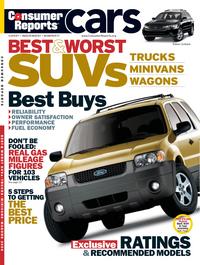Consumer Reports Best & Worst SUVs, Trucks, Minivans, Wagons 2006 Identifies Gas-Guzzling and Fuel-Sipping Vehicles
Ford Escape Hybrid, Lexus
RX400h rated best in fuel economy for small, midsized SUVs
YONKERS, NY – Consumer Reports’ Best & Worst SUVs,
Trucks, Minivans, Wagons 2006 identifies gas-guzzling and fuel-sipping
sport-utility vehicles, pickup trucks, and more based upon
CR’s own independent fuel-economy testing. The gas guzzlers,
which posted figures as low as 11 miles-per-gallon, are manufactured by a
variety of domestic and foreign companies.
Consumer Reports engineers run vehicles through a series
of tests to determine real-world fuel economy numbers for city, highway,
and overall fuel consumption. Those numbers can help the consumer determine
which vehicle may best suit his or her needs, and household budget.
“Fuel costs for a full-size pickup truck or sport-utility
vehicle can easily cost you thousands of dollars per year,” said
Consumer Reports’ Automotive Editor Rik Paul. “Fuel
costs need to be factored in by new-car buyers along with such other key
factors as the vehicle’s purchase price, performance, safety,
insurance cost, and predicted reliability.”
Consumers Reports’ best and worst in fuel economy
lists are based on overall miles-per-gallon (mpg) performance in
CR’s real world fuel economy tests. The best and worst
vehicles selected are the most notable standouts from each vehicle
category.
Here’s a quick look at the best and worst in each category
from among all the vehicles CR has tested based on overall mpg
ratings:
Small SUVs
Best: Ford Escape Hybrid, 26 mpg;
Honda CR-V EX, 21 mpg; Subaru Forester 2.5X, 21 mpg.
Worst: Jeep Wrangler Unlimited (6-cyl.), 14 mpg;
Jeep Liberty Sport (V6), 15 mpg; Kia Sorento EX (V6), 15
mpg.
Midsized SUVs
Best: Lexus RX400h, 23 mpg; Toyota
Highlander Hybrid Limited, 22 mpg; Nissan Murano SL, 19 mpg.
Worst: Chevrolet TrailBlazer EXT LT (V6), 13 mpg;
Land Rover LR3 SE (V8), 13 mpg; Hummer H3, 14 mpg.
Large SUVs
Best: CR’s testing
results showed no vehicles with unusually good ratings for fuel economy in
this
category. Worst: Dodge Durango Limited (5.7), 12
mpg; Ford Expedition Eddie Bauer, 12 mpg; Chevrolet Suburban
LT, 13 mpg.
Pickups
Best: Subaru Baja (4-cyl.), 20 mpg;
Toyota Tacoma (V6), 17 mpg; Chevrolet Colorado LS
(5-cyl.), 16 mpg. Worst: Dodge Ram 1500 SLT (5.7),
11 mpg; Dodge Ram 1500 SLT (4.7), 12 mpg; Chevrolet Avalanche
(5.3), 13 mpg.
Wagons & Hatchbacks
Best: Toyota Prius, 44
mpg; Scion xB (AT), 30 mpg; Pontiac Vibe (FWD), 27
mpg. Worst: Volvo XC70, 18 mpg; Dodge Magnum SXT
(V6), 19 mpg; Mazda6 s (V6), 19 mpg.
Minivans
Best: Honda Odyssey EX, 19 mpg;
Mazda MPV LX, 19 mpg; Toyota Sienna XLE, 19 mpg.
Worst: CR’s testing results showed no vehicles with
unusually poor ratings for fuel economy in this category.
How CR Calculates Fuel
Economy
Consumer Reports’ overall fuel economy results are
calculated by an equally weighted average of city, highway and one-day trip
mpg ratings. CR’s city mpg tests are stop-and-go driving
simulations, which have 18 stops, a total of 4 minutes of idle time, and
speeds up to 40 mph. CR’s highway mpg tests are run on a
section of highway near CR’s testing facility. Two testers
make eight 5-mile runs at a constant 65 mph. The tests are run in both
directions to limit the effects of wind and grade differences.
CR’s one-day trip test represents a mixed driving cycle. Five
different engineers drive vehicles back-to-back on the same day over a
31-mile route that includes 26 percent freeway, 11 percent highway, and 63
percent stop-and go-driving conditions.
For complete Consumer Reports fuel economy test results
or further explanation of testing procedures visit www.ConsumerReports.org.
Consumer Reports’ SUVs, Trucks, Minivans, Wagons 2006
offers expert reviews of every major model for 2006, along with
CR’s exclusive ratings for performance and safety, reliability
histories, test results, owner satisfaction, and more. The publication also
includes five feature stories, including what’s new for 2006, getting
the most out of your fuel dollars, and an in-depth look at critical safety
concerns. Other stories examine how to pick the best vehicle for you and
five steps to getting the best deal.
Consumer Reports’ SUVs, Trucks, Minivans, Wagons
2006 ($5.99 U.S./$6.99 Canada) is available everywhere magazines are
sold. The special publication can also be purchased online at www.ConsumerReports.org/newcars.
Buyers can also visit www.ConsumerReports.org for more
information, all types of vehicles, from sports cars to pickups. The Web
site’s free area contains extensive information on buying a car,
checking a used car, and interactive tools to help you buy or sell a car.
Site subscribers pay just $4.95 per month or $26 per year ($19 for
Consumer Reports subscribers) to access in-depth features, including
ratings, recommendations, and advice on hundreds of cars and trucks.
Consumer Reports’ Auto Price Services’ New
Car Buying Kit is an interactive tool that guides shoppers through the
buying experience and offers the latest information and pricing, as well as
test results, side-by-side comparisons for fuel economy and more. A
three-month subscription to the New Car Buying Kit costs $39. Individual
new car-pricing reports are available for $12 at www.ConsumerReports.org.
Consumer Reports is one of the most trusted sources for
information and advice on consumer products and services. CR has the
most comprehensive auto-test program of any American magazine;
CR’s auto experts have decades of experience in driving,
testing, and reporting on cars.



